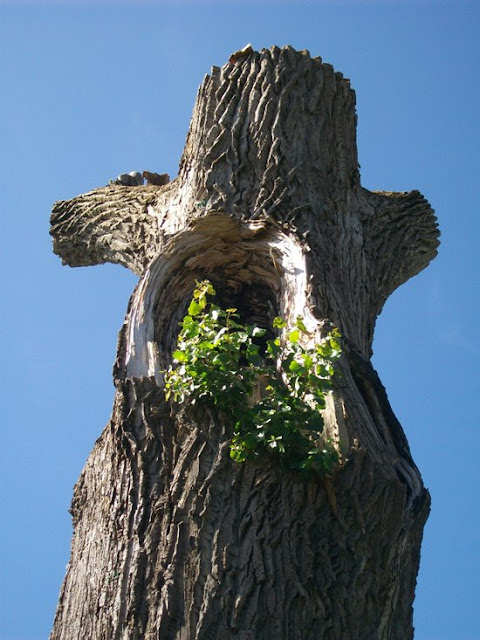This was probably the paragraph, in the Heritage Trail brochure, that helped me decide what to do with a glorious Saturday last weekend in Tauranga -- go off and find history. Of course, eagle-eyed readers will spot the proofing error, eh?
So -- a tree on an urban heritage trail. Great, I thought. Let's take a look.
Actually -- it ended up having more of a story than I thought.
There have been some sad articles of late in the local papers about this tree.
A bid to save Tauranga's giant 146-year-old aspen tree in Willow St is under way today after a massive branch crashed to the ground yesterday, narrowly missing parked cars.
Tauranga's giant and historic aspen tree is to be reduced to a mere shadow of its former self, once arborists finish chopping 16m from its 34m height ... The 146-year-old American cottonwood dates back to the era of the Battle of Gate Pa and is reputed to be Tauranga's oldest living thing.
The death knell has sounded on the stunted remains of Tauranga's once mighty aspen tree. A close 6-5 vote by the Tauranga City Council decided the fate of the 146-year-old landmark tree that dates back to the Battle of Gate Pa.
The future of the formerly magnificent tree, on its own reserve in Willow St, looked in doubt when a massive branch crashed to the ground on January 17, exposing just how far rot had spread. With a mere 10cm wide circumference of live wood supporting the tree, it was going to have to be cut back to a stump in order to survive in safety - a process called pollarding.
Some councillors wanted to give the aspen this last chance and then allow it to regenerate from there. However, parks team manager Steve Webb said that even if the stump grew back into a reasonable canopy, it would still have to be cut back to a pollard every couple of years. Although it was hard to know how long the aspen would survive by pollarding, he was confident it would live for another five years.
So ... here it is.
It isn't an aspen, apparently: more likely, a Canadian cottonwood. The idea of it stemming from a trooper's piece of tethering post is called into question by the marble plaque at the base of what's left of the tree.
The Tauranga "Aspen" Tree.
Although referred to as the aspen, this tree is in fact populus canadensis (Canadian cottonwood), a name covering many hybrid varieties between P. balsamifera and P. nigra. Therefore in the strict botanical sense it is only a cousin to the true aspen, P. tremula.
Legend places the tree's origins in the hands of a soldier who dismounted from his horse and pushed his switch into the fertile soil. History however tells that the tree originated as part of a shelter belt planted in the 1860s to shelter the gardens of the Church Missionary Society's Maori Boys School that was part of the Mission Station.
You can't stop a good story with facts, though. Apart from the relatively recent heritage brochure's paragraph, there's even a rest home diagonally opposite the tree's site -- named Aspen.
This bit got me, though. The interior of part of the tree is filled with cement -- apparently in a bid to support the internally-rotted tree, and in the aftermath of fireworks damage. How much is tree and how much is cement, I have no idea.
So, there you have it. They're trying to preserve the old landmark for a few years yet, but -- right now, it is definitely a sad, patched-up sight. Feeling sorry for the tree, I moved on.
Update 3 July 2011: I've received the following email today from historian John Webster.
Lisa,
I've been home just over a week now and should have mentioned to you that the elm/pine tree you admired in Tauranga - the one to which settlers hitched their homes - is sprouting new leaves and branches, very high near the crown and a little down one side (I have photos to prove this) - I was stopping at the Strand Motel just in front,which is only one house section away from the small reserve in which your tree stands...so every day on my way to the Textile Confrence I saw your iconic survivor! Even the bark seemed in good condition for one so old.
John W.
Hopefully, this means hope is not completely lost for the old tree.


























































